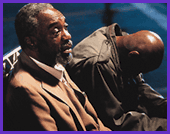A table lamp provides the nominal light source, but Bailey ended up using multiple units to suggest his illumination. He used colored Kino Flos to simulate neon rims and backgrounds. Additionally, he lit below and behind the bar with blue Kino Flos, and also illuminated the liquor bottles on the shelves. Pulling the bottles out from the back of the shelf a little bit, electricians laid down 4' or 8' fluorescent tubes (depending on the shelf size), and then repositioned the bottles in front of the lights. "That [technique] made the glass glow, and it also provided a little bit of depth," remarks Bailey. "We also put a Kino tube below the bar surface, where the sink and soda dispenser were," he continues. "We often put fluorescent tubes down as low as possible, to provide a bottom light shining up at the bartender or anyone else who was behind the bar. It was a nice source light. Most of those were neutral or slightly on the coolish blue side. I was lighting the foreground warm and the background cooler in contrast."
To warm up the light, Bailey used either straw gels or a 1/4 or 1/2 CTO, but overall he tried to keep his array of gels fairly simple. "Again, there's that whole notion of it being reductive," he comments. "If I wanted warmth, I used an 1/8, 1/4 or 1/2 CTO, rather than going through a lot of different kinds of straws or ambers and mixing a lot of things together. If I wanted a cool light, I tended to use a 1/8, 1/4 or 1/2 CTB."
The film's last scene is particularly moving. This climactic moment shows Socrates and Burke crossing a street and sitting together on a bench at a bus stop on a concrete island in the road, after which Socrates boards a bus. In the background, stretching out behind the men, is a park, which was illuminated by an 18K on a Condor. "Instead of lighting the bus stop area with one strong source, we rigged an overhead light directly above the bench, as if it were a high streetlamp," explains Bailey. "It was just a pool of light, encompassing the bench. I had to cut light from our big HMI in order to light it."
Spot Pars lit up trees in the park behind the two men, providing a sense of depth. "This was the end of the movie, the characters' last scene together," Bailey notes. "They are two men sitting on a bus stop bench in the middle of the night, and I wanted to isolate them from the rest of the world. It was their final moment together a moment out of time and I wanted it to have a kind of suspended feeling. We lit the scene that way not because we needed a source light illuminating them; I already had a source light from the HMI over in the park. Rather, we wanted an individual light that sealed them off from the rest of society."
According to the cameraman, the decision to light the scene this way was purely emotional in nature and had nothing to do with photographic demands. He observes that over the years, his work has become more instinctive, an approach he strongly endorses. "I used to talk about how I plotted the scenes and planned the work. Now I find — especially with films about character and relationships — that I work more and more without a game plan. I immerse myself in the material and try to stay responsive to it."
Bailey notes that it is not until a picture wraps that he is usually able to offer reasons as to why he made certain creative choices. "Some cinematographers are truly visualists; they are predominantly interested in the purely visual development of the film," he muses. "I'm interested fundamentally in the dramatic and emotional values that are intended, and the photography is the device that you use to do that."
Of course, he points out that a greater degree of time and thought is required for action-oriented or effects-laden films which employ bluescreens, motion-control rigs or mattes. But for films without such technical considerations, where setups involve just the camera and the actors, what matters is what people bring to the set every day. That's why attending rehearsals are of paramount importance to Bailey. During these sessions, he can talk to the director, watch the blocking and explore the rhythm of the scene before principal photography begins.
Assessing his most recent project, Bailey says that he views Always Outnumbered as a dramatic, literary work which is more oriented toward character and performance than technical logistics. "I loved doing this film," he concludes. "If you feel you are connected emotionally to the material, you have to trust that instinct in the same way a musician who is in the flow may play without concentrating on the notes, or a dancer can perform without concentrating on the steps."
